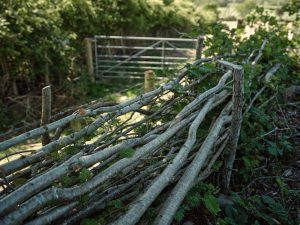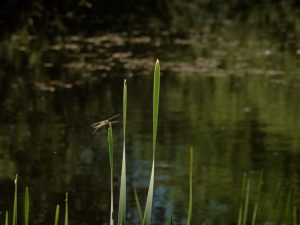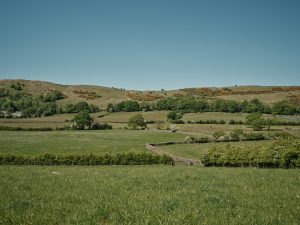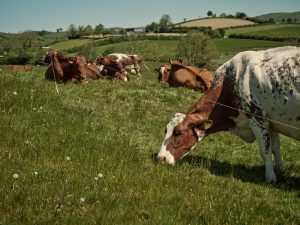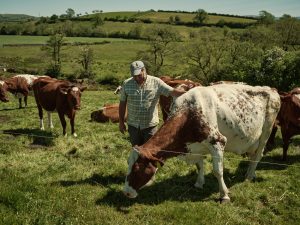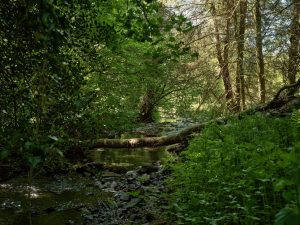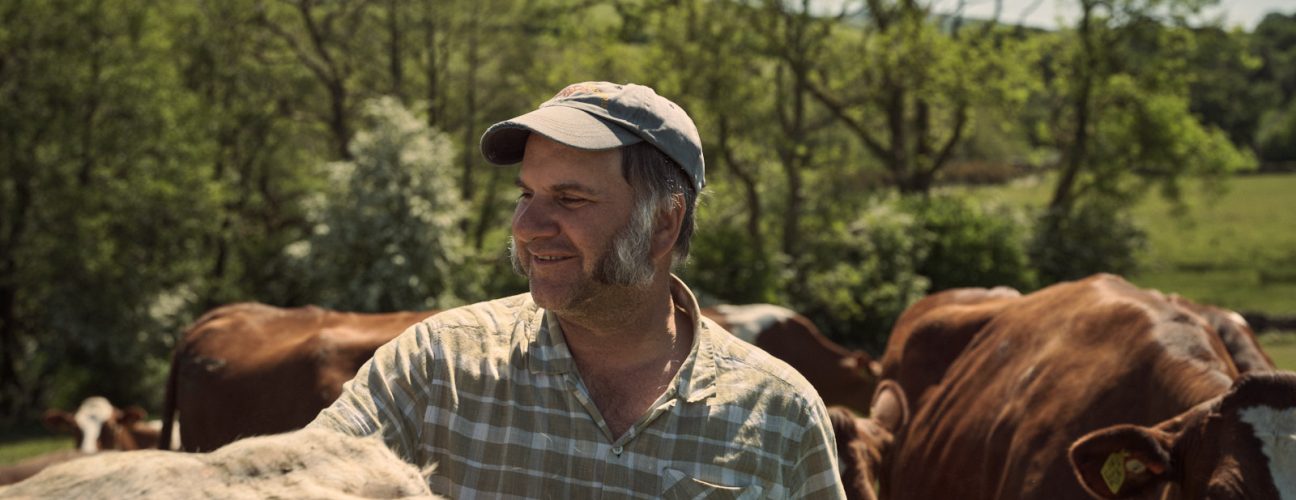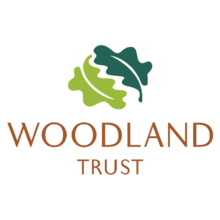James Robinson
Strickley Farm, Old Hutton, Kendal, Cumbria
I farm here with my dad and my son Robert – we’re all fulltime, dad doesn’t slow down at all! My wife, Michelle, manages school visits and helps out a bit on the farm and mum does a lot of the paperwork, so it’s very much a family business. Michelle is a part-time teacher as well. I’m the fifth generation, my son Robert is the sixth.
We’d describe our approach as being long-term (20 years) organic dairy – it’s about using the animals or farming in a way that is right for the farm, this area, the topography of the land, the habitats we’ve got and that we want to establish, and not trying to push anything too far, but farming within the farm’s means. We are moving towards regenerative… with organic, because it’s certified, you can only get to a certain point… we’re always trying to do much more on top of that which lends itself well to the regenerative moment.
The farm would have been established around 1200 (similarly to other farms around here) and we have farmed here since 1875. It was a tenanted farm at that time under the big estate and they sold off some of it for death duties etc. in the 1940s. My great grandfather was a tenant here and was lucky enough to buy it, and we’ve gradually bought farms and patches of land next door; the last being 6 years ago when we bought next door’s farm. We now have 121 hectares (ha) that’s in a nice ring fence, bar a 12-ha allotment. We are lucky to be able to call it our own and to be able to make all the decisions within that. Within the 121 ha, the average field size on the farm is less than 2 ha. 60 fields are all surrounded by either a managed hedge or drystone walls. We have the drystone walls further down the farm where it’s stonier and up on our allotment, then the rest is hedgerows.
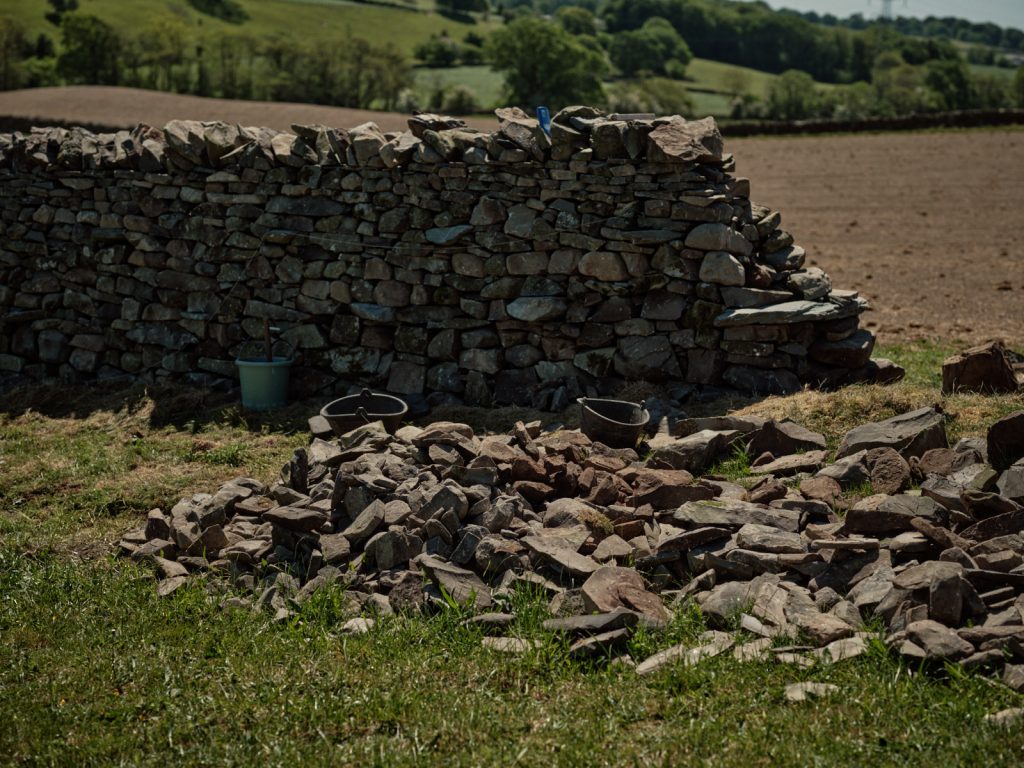
We have about 120 adult cows (Dairy Shorthorn) plus a number of followers, so about 250 cattle, and a small number of sheep. The Dairy Shorthorn is a native breed that is well suited to converting the grass that we’ve got into milk. It’s very much a grazing herd and we try to extend that grazing season as long as possible – from the middle of March into early November. It is one of the reasons why we need trees and hedges for shade and shelter.
It’s been a closed herd for about 15 years now, all home bred, and we also sell surplus stock for other herds, with the rest of our income coming from milk. We’ve recently invested in a second-hand kit for processing our own milk. The building to put the kit in is partway through getting converted. It’s a big investment and quite a change for us to then sell direct.
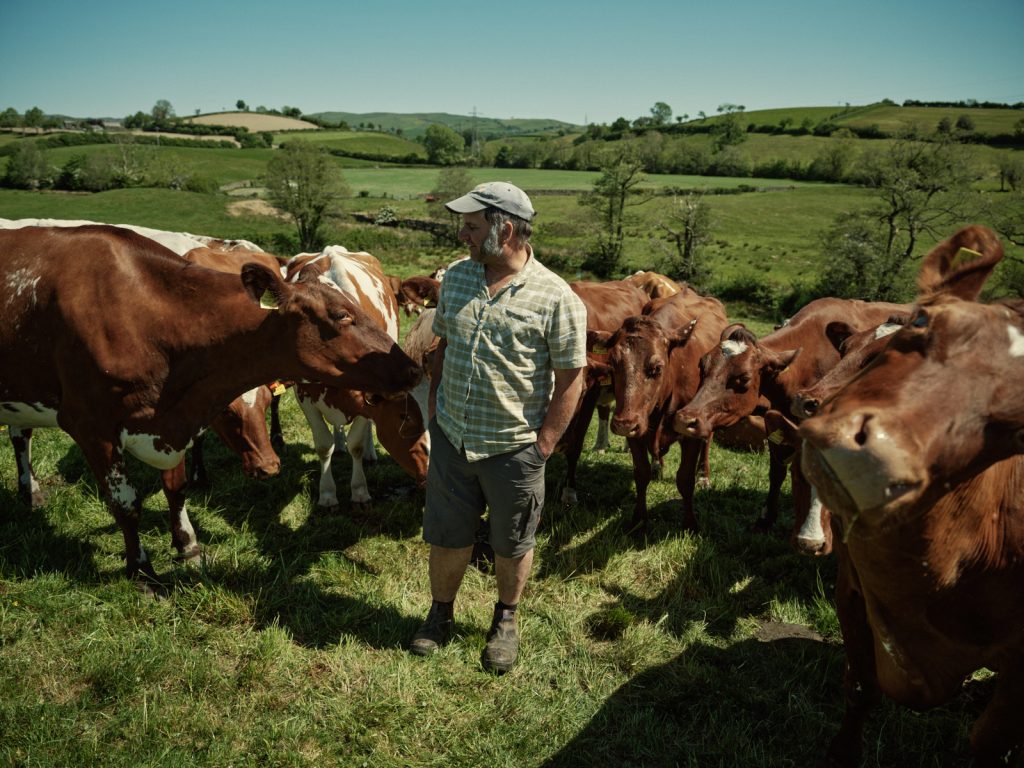
The cows are milked twice a day then go straight back out to grass again – in wintertime they get the silage and hay in the barns. The cow herd average at just under 7,000 litres, with us trying to get as much off grass as we can. The cows are mid-size (about 550 k adult body weight), which is ideal for navigating some of the banks that we have and they also often have to walk a long way – it can be about 3/4 of a mile down to where they graze, then they’ve got to walk back and go out for another night grazing as well. So we need an animal that is well suited and robust, and that’s what the Dairy Shorthorn gives us.
We were selling milk to Yew Tree Dairy (a family-owned dairy in Warrington / Skelmersdale area). They were bought out by Muller in November, so we are currently supplying Muller Organic, but from the 1st of July we’ll be supplying Organic Herd – an organic dairy cooperative that used to be called OMSCO. We will also be selling our own milk direct by the end of July, and that will be available through Booths supermarket who have been very supportive. We’ll also be supplying other local businesses… people who are interested in how their food is produced, how the cows are helping to manage the land etc. We’re on that nature friendly farming kick you might say – it’s not just about producing milk, it’s not just about producing organic milk, it’s a step beyond that… I’m chair of the Nature Friendly Farming Network England steering group.
We host school visits (which are very much part of the farm income) under the stewardship schemes, and have just started a very small-scale enterprise with a company called Wild with Consent, where people can bring their camper van and camp under a beautiful old oak tree down by our pond and beck and have it exclusively to themselves. I think it’s quite a good little earner – there is no infrastructure at all, whatever they bring, they have to take away.
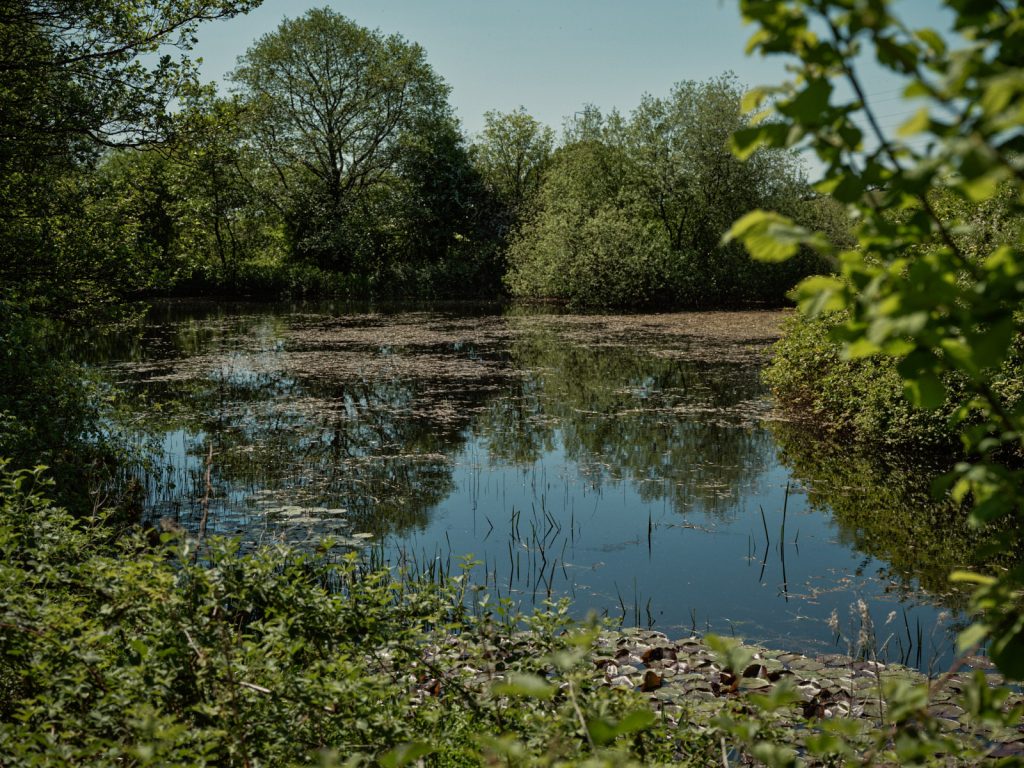
Climate resilience and the longevity of the farm very much go together. With tree planting, we’re trying to create areas the cows can go in to when we experience some of the climate extremes. We need to try and make our farm resilient to either long periods of rainfall or drought. When we look around, we can see that our fields are actually looking pretty good compared to our neighbours. A lot of that is down to the organic status. With having been organic for 20 years, our fields have much deeper roots and diverse swards than neighbours’ fields that have single species ryegrass maybe and are much shallower rooted. We have 3 species-rich hay meadows that we manage very differently and they contain many wildflower species including wild clover, yellow rattle, and plantain…
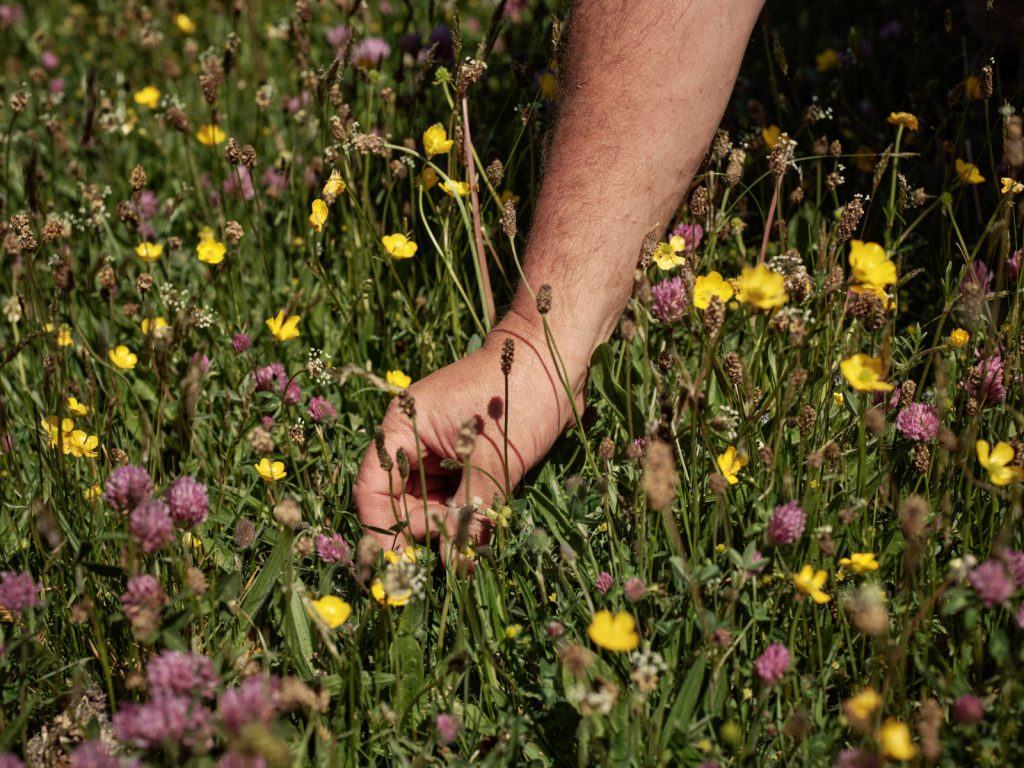
We’ve been in environmental schemes since 1991… 97 ha of the farm is under a higher tier. The 24 ha we bought 7 years ago was under a mid-tier – we came out of that end of 2024 so I applied for an SFI, and all of it is now under an SFI with the same options that were available under mid-tier. We have a year and a half left on the higher tier… When that finishes, hopefully the Government will have sorted themselves out, and we can put the whole farm under one agreement… at the moment nothing’s quite tied in, in terms of time. We are also mid-way through applying for a Woodland Higher Tier – we were asked to apply for that because we had a woodland management plan done… we’re working with our local Forestry Commission chap to get that done.
Sustainability in practice
Agroforestry
Aside from the hedgerows and wood pasture, we’ve got a couple of small areas (awkward field corners) that we’ve planted up in the last 15/20 years, and an ancient oak woodland. Many of the oaks on the farm were used as marker trees within the landscape.
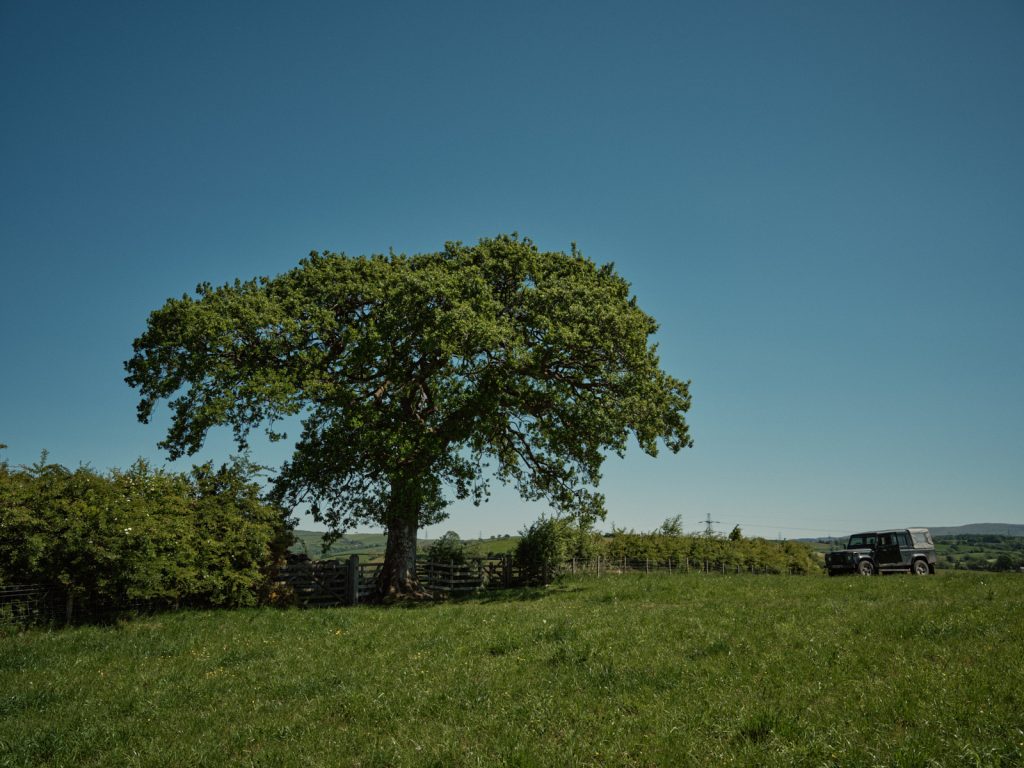
A lot of the oak woodland was re-planted where it had been felled over the years, so there are some new oaks in there and a lot of natural regrowth and species such as holly and hazel… we might go down the route of hazel coppicing. We do use some hazel for hedging stakes when we do the hedging. The woodland is next door to a pond that was created at the same time the wood was fenced off, and that has about 2 ha of 30-year-old woodland around it as well. Some of that is willow scrub that has been left to grow which provides a different habitat as well.
Trees as living barns
When walking up from milking on a hot day, the cows always want to walk by the hedge side because they want that shade and shelter. On savage mornings in September when it’s nearly dark and we’re going out for the cows and it’s been blowing all night, we’ll always find them on the other side of the hedge from the wind sheltering – the hedges give a lot of shelter from both the wind and rain. Your cow will always know where to stand or lie and will generally stand up under a hedge when it’s raining, so it is almost like a roof over them in many ways – especially with our big hedges.

If you flail hedges to a metre high and have a nice metre box, they look neat and it does break up the wind a bit, but there’s very little shelter for the cows. We don’t want to be having to bring our cows in because it’s too hot. I want them to be as comfortable outside as cows are in some of these fancy barns that people put them in! It’s much cheaper having them outside too.
We don’t generally plant non-native trees, although there have been some planted in the past. We’ve just planted 4 female and 1 male black poplar, having been lucky enough to get some cuttings from the Cumbria Wildlife Trust. It will be nice to have some in 100 years’ time. Historically in this area ash was one of the main hedgerow standard tree species planted. Unfortunately, many of the trees that we’ve planted over the last 30 years have succumbed to ash dieback.
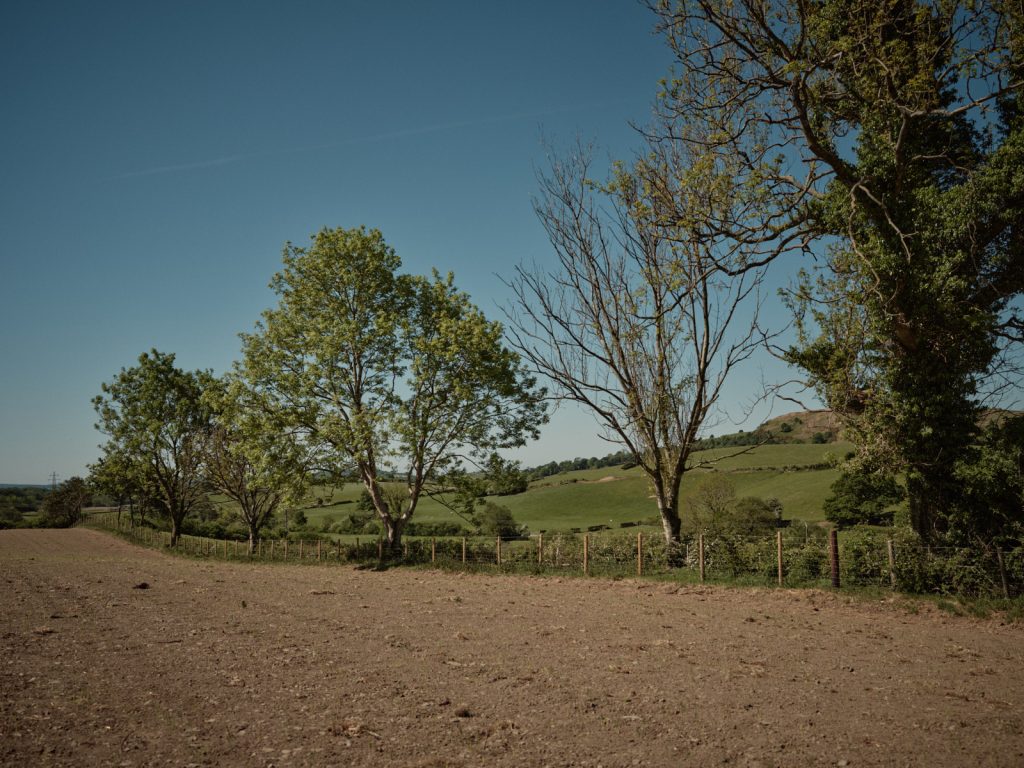
We’ve got some mature trees, they’re looking quite good still…. But we’ve had the clinical signs of ash dieback for probably the last 8-9 years now.
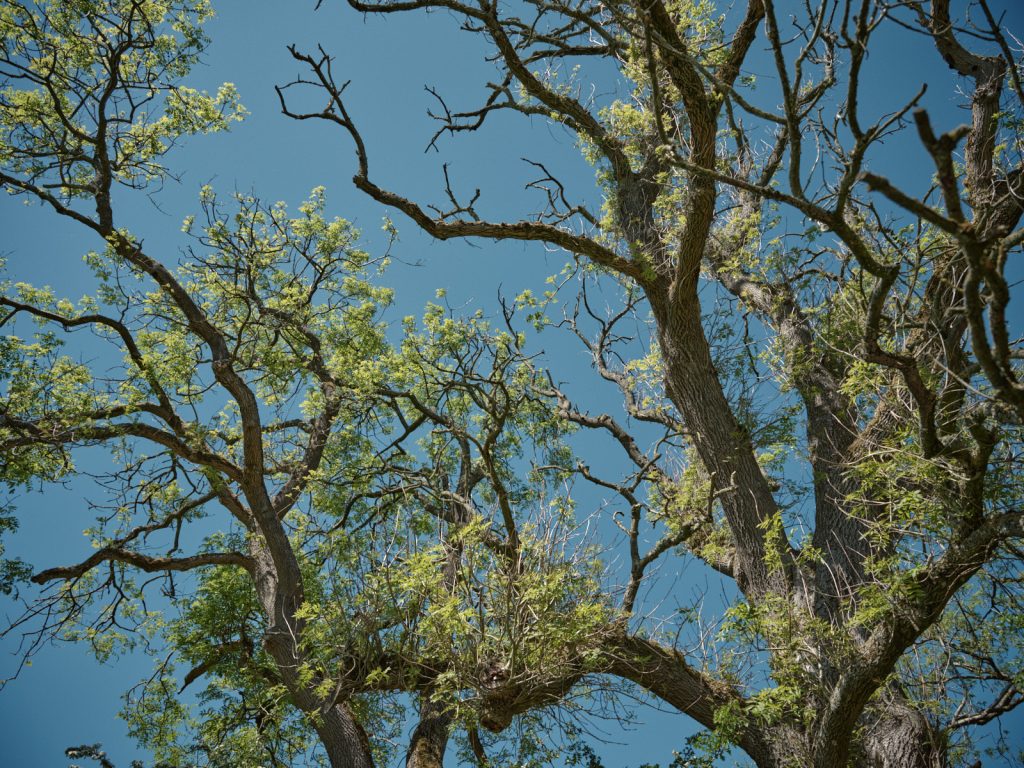
Anywhere near water, we tend to plant alder; it is ideal for planting down the beck sides and is also nitrogen (N) fixing but is quite bitter for grazing because it’s high in tannins. However, if a cow needs something that’s high tannin, they will eat it, it’s all about giving them that choice. We do put some fruit trees (including apple trees) in occasionally because with 7.5 miles of hedges, we might as well! Sometimes they fruit really well and we pick them, sometimes we don’t. But it doesn’t matter – they drop on the floor, it doesn’t matter.
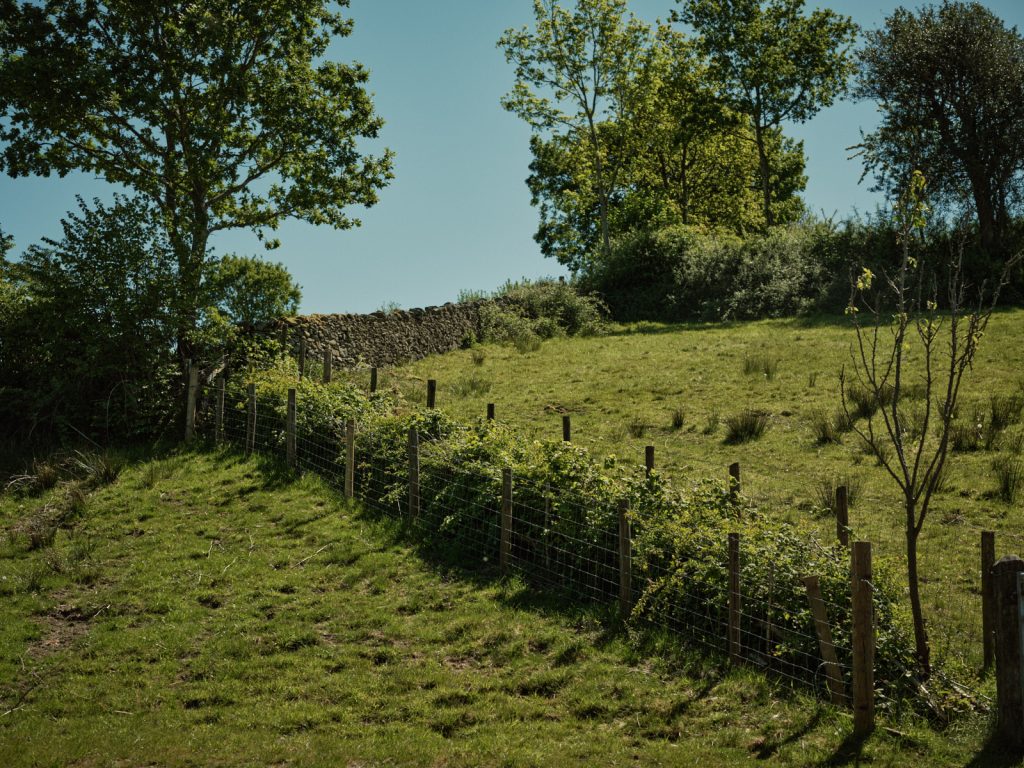
We’ll always plant species like crab apple because they’re so good for pollinators… In terms of things for the cattle to potentially browse, we put a bit of willow in where it’s wet because it’s great for self-medication for pain relief with the salicyllic acid that’s in there … Having multi-species dotted about in the hedges gives the cows the chance to eat what they want at a certain time depending on what they require.
At the moment (June) you’ll see cows when they’re going past the hedges nipping the tips off the hawthorn – it’s really nice and juicy, but they’re not going to have hawthorn at the end of the year when they’re dry and wiry. So it’s about having that mix at different times of the year, which also gives the cows more resilience to any potential diseases that might come in.
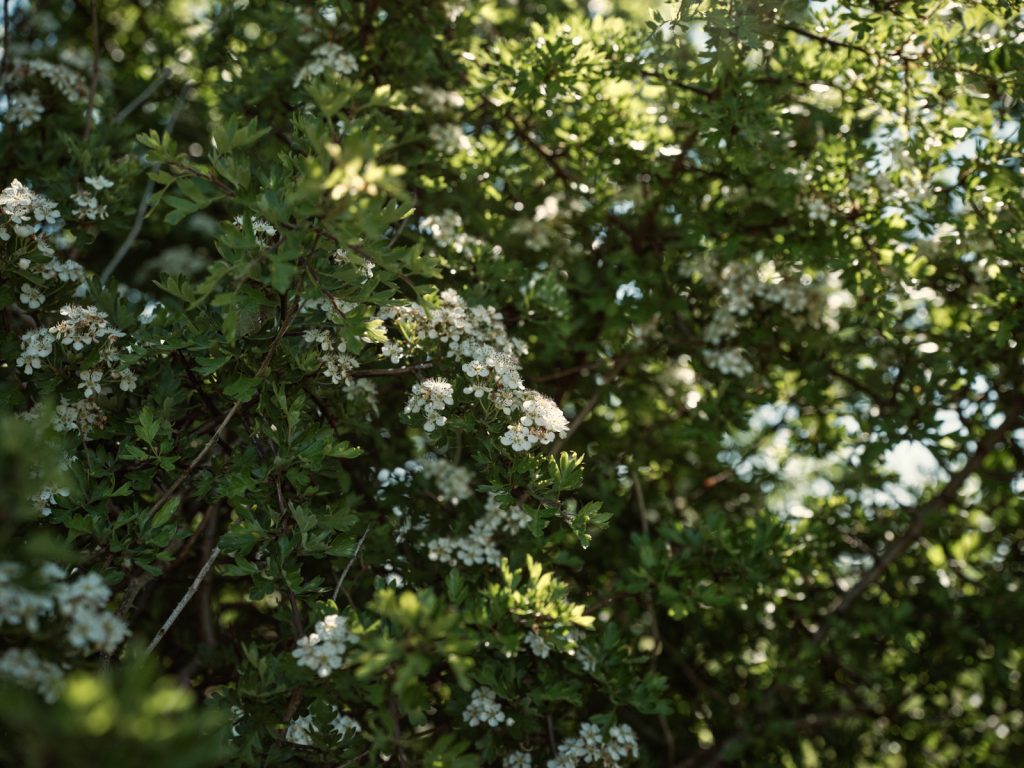
Climate change impacts on the farm
There are areas which are much wetter than they were – we’re getting 10% more rainfall than we were 40 years ago. I can remember my dad baling hay on fields we can barely get a tractor in now. The pace is going to quicken, so we need to make sure that we get things in place now for the future because it’s no good thinking we need more trees in 20 years’ time.
Last year (2024) was a very wet spring, but three of the last four springs, we’ve had these long periods of dry spells. We don’t really get those April showers that we’re used to anymore. We need to be more savvy and not expect that rain is always going to come or that we’re going to get big doses of it. With Storm Desmond and the floods in 2015, a phenomenal amount of rain came (about a foot in a day), which caused huge damage to the infrastructure up and down the beck – there’s not a lot we could do to stop that, but we’ve got to make sure that with these 100 year events, which are probably going to become much more regular, we can manage them as best we can.
We’ve had temperatures here of 35/ 36°C. We never used to get anything like that – mid 20s and it was a hot summer! We’re now seeing temperatures that only used to be experienced in the south of England. And if predictions are right, we’re going to see them potentially two or three weeks on the trot. We have to make sure we’ve got everything in place to provide the shade, shelter and water… Even down to the way we’re putting our tracks in, if the cows haven’t got shade and shelter on a track and it’s right down the middle of a really bare field which takes them 20 minutes to walk across, they can overheat.

Cows generate a lot of heat when they’re just standing still as well as when they’re lying or walking. They have a great big oven inside of them bubbling away all the time like a massive central heating system. It takes a lot to cool an animal down, so things like that add stress to the animal. Changing the way we’re doing a track or planting trees down the side of the track reduces stress and gives them some respite as well.
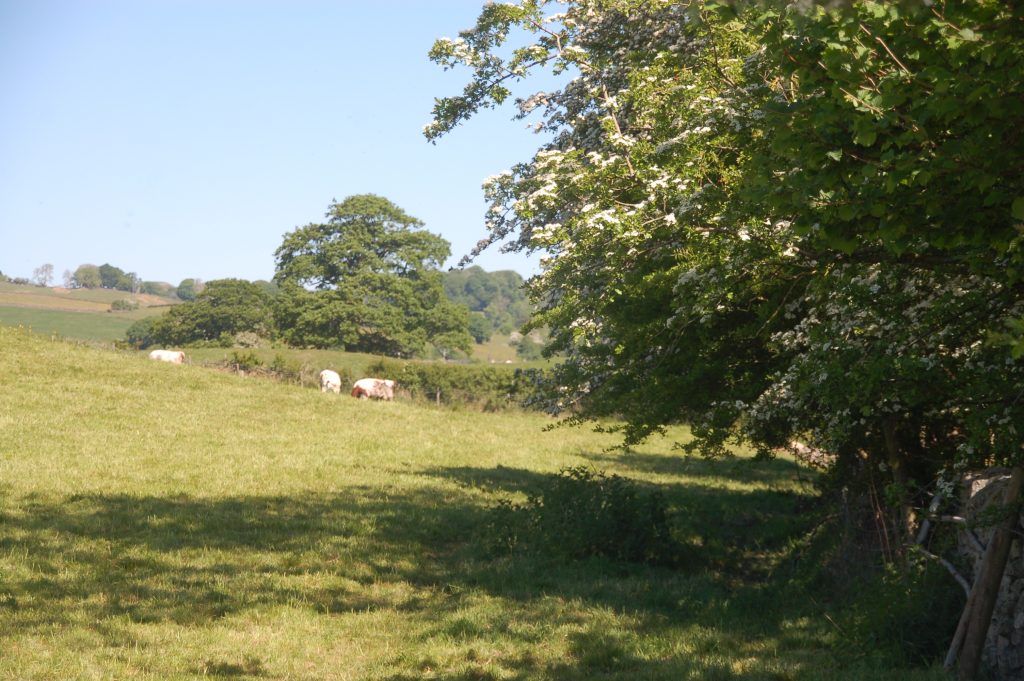
Temperature stress
Yield is one of the main impacts of temperature stress that is immediately obvious. You’ll see it within the next day, but you’ll also have fertility impacts – which you don’t see for 3-6 weeks when you’re doing your Pregnancy Diagnosis sessions. After cows have experienced that high degree of stress, that’s when they get potential foot problems – always about 6 weeks behind. So you have your initial milk yield, then your fertility problems, then your potential foot problems, and it then becomes very hard to get out of that cycle. If you can nip it in the bud at the start and not give them that stress, you’ll hopefully mitigate most of the problems that come afterwards.
Wood pasture
18 months ago we put in about 4 ha of wood pasture (multi species in-field trees) to try and future proof for a bit of shade and shelter. It’s also a riparian strip so will help with flood mitigation. We’ve done a form of companion planting (see below) where we’ve planted a standard tree such as hornbeam or bird cherry in the middle, and then 3 scrubland species around the outside of it, all within a cactus guard. Those 3 species then become the scrub that’s going to protect that big tree. The mycorrhizal activities from at least 4 different species together is much better than having just one species, so we get multi benefits from doing this…
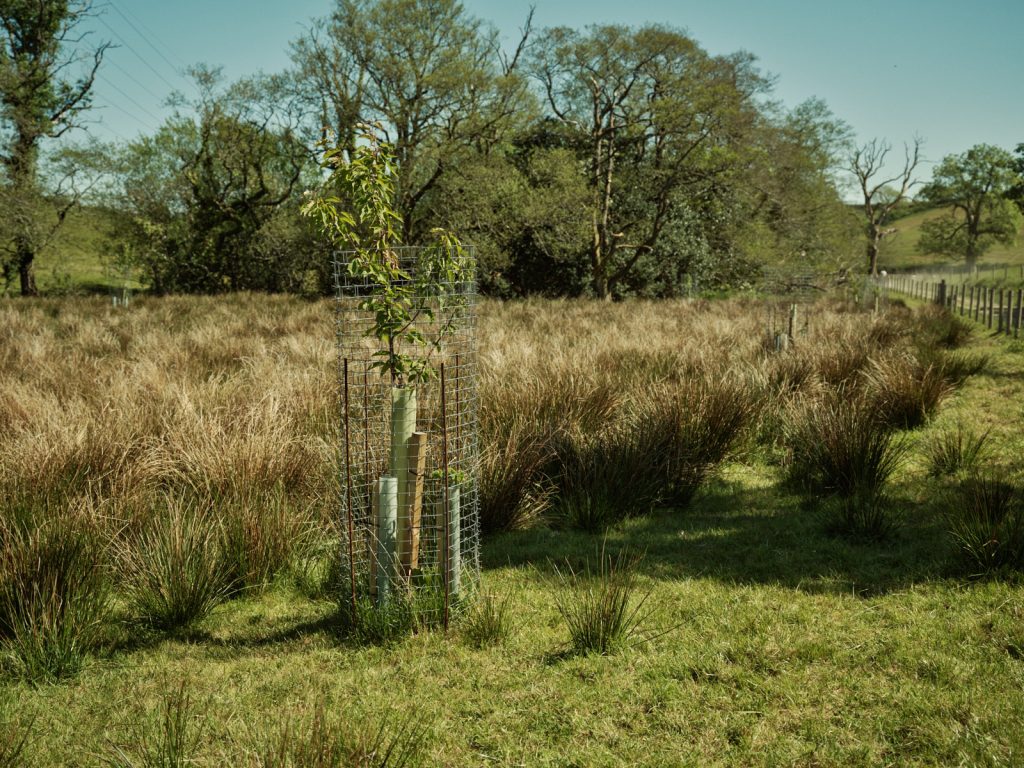
With areas like this, smooth rush becomes very dominant, but it doesn’t really like shade so we’re hoping that when the trees become more established, the rush will become less dominant and allows other species to come in. It also gives us more production – you plant a tree; you’re improving your production. You’re also creating that 3D habitat and 3D grazing – increasing the surface area of grazing. In 20 years’ time, instead of devaluing an area because you planted trees in what is seen as more productive land, it might be that you’ve increased the value because you have the trees in it.
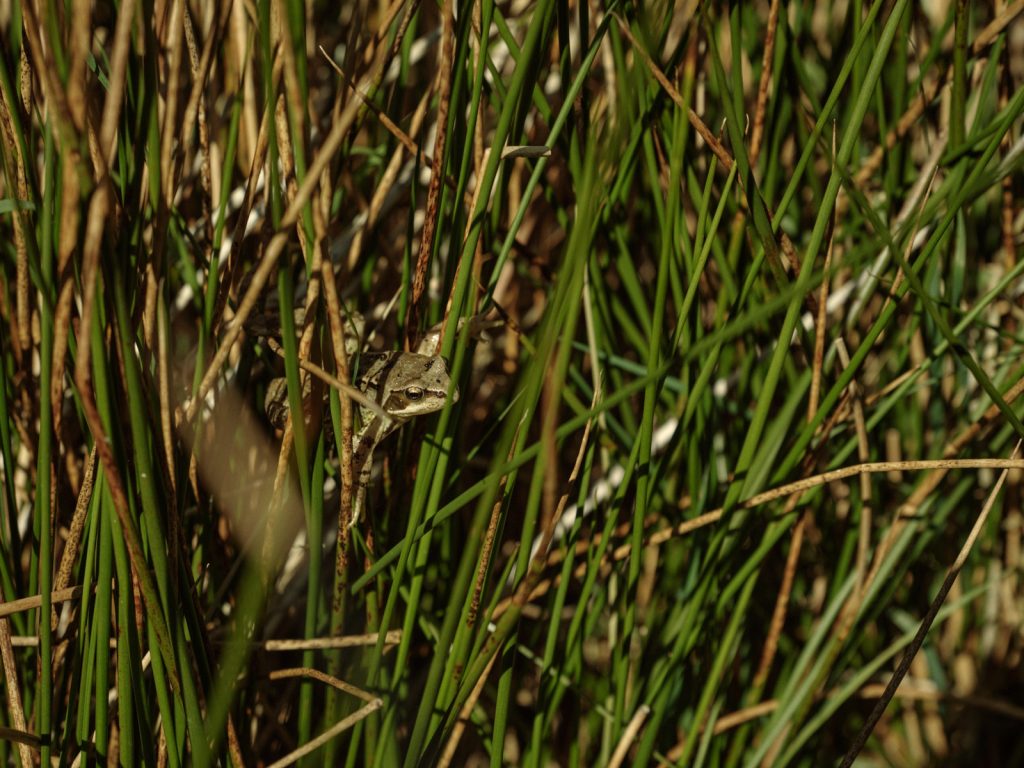
The alders in this area are getting to the limit for age. We bought this bit of the farm in the 1950s – looking back at historic documentation we have seen that the alders were coppiced and used for things like clog making. It can be a valuable tree, maybe we should start manging them similarly – coppicing for firewood perhaps. It would also help to rejuvenate the trees.
We have put the wood pasture in with the intention of allowing calves to come down into it when they want – they may only be in it for 2 days a year or it might just be one afternoon when it’s extremely hot, but it just gives them that opportunity. If a calf nibbles something like this oak (below) it doesn’t matter as long as they don’t take the growing tip out, but I wouldn’t allow cows to…
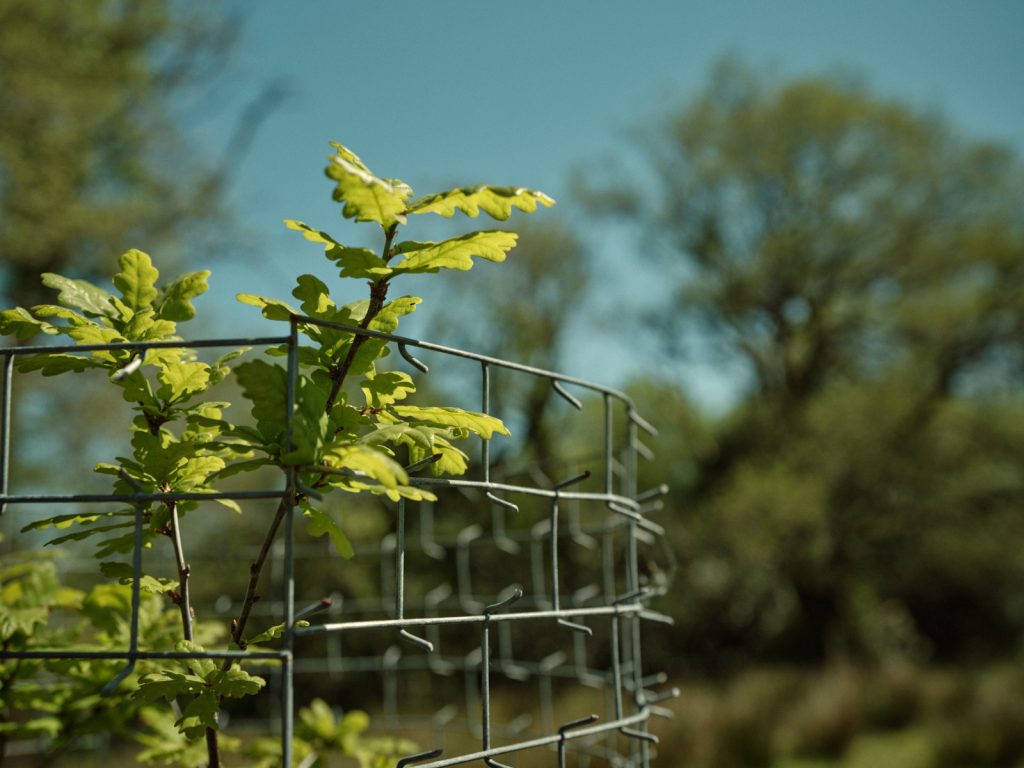
In the last 5 years, when we realised that the ash was dying, we’ve been planting hornbeam in their place. We were pretty much on the edge for where hornbeams would establish easily – they’ve all grown really well in the wood pasture, in fact they have probably done better than any other species – maybe that’s indicative of climate change – the fact that we’re now very much within their normal growing area. Having multi species is absolutely key.
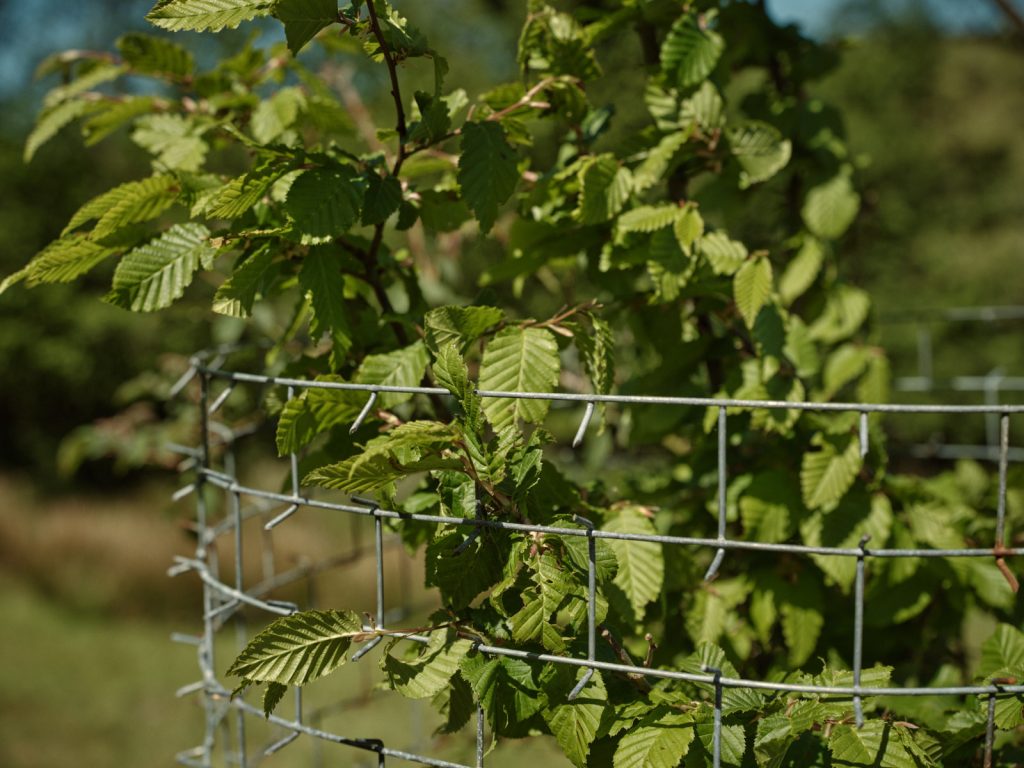
Calves can do damage to beck sides… 15 years ago the hedge on the other side of the beck in this area (see below) wasn’t there – it was just a wire fence. Each year when it flooded, we had to patch the fence up and keeping stock out was always a challenge, so we decided to replant a hedge with hazel, hawthorn, alder… Beside the hedge (typically) there is a lot of scrub. The scrub is just as important to us in terms of habitat – the bramble and blackthorn provide food and a wildlife corridor. The banking now is much more stable, there is shade over the water, and shelter for stock both sides… you can quickly establish a stockproof boundary and a habitat that is benefitting both the farm and the watercourse.
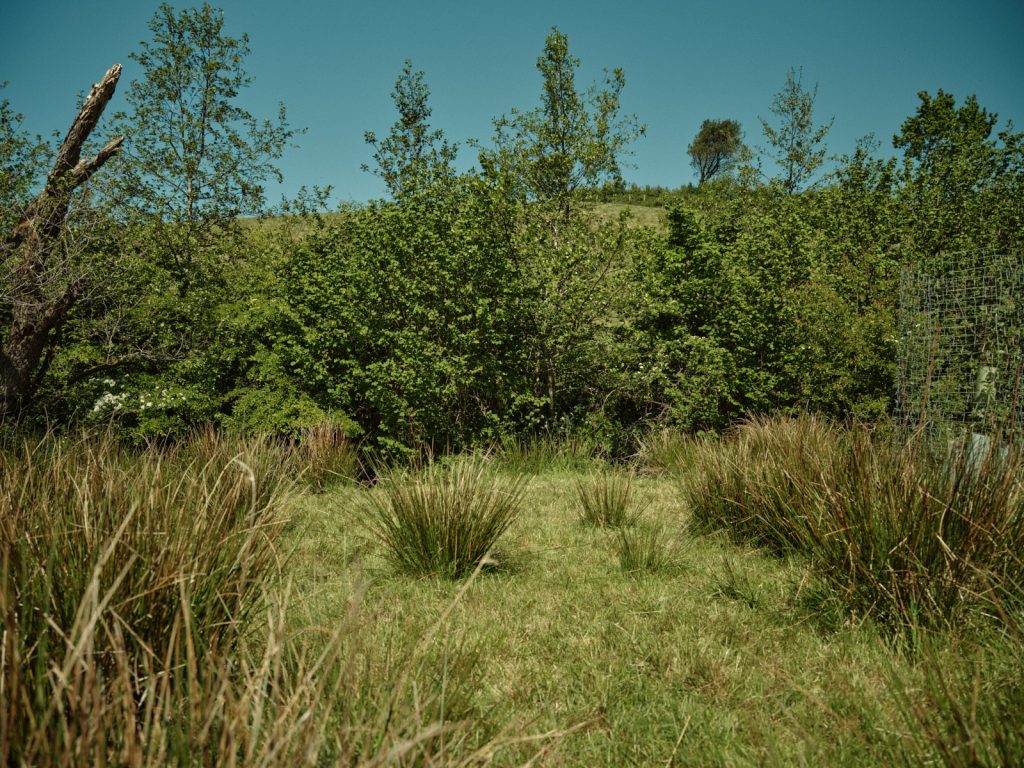
Hedgelaying and hedgerow management
We’ve always done hedgelaying, whether it’s been under a stewardship scheme or not, it’s just part of something that we do every winter. Having funding there for farmers to either plant hedges or manage hedges a different way or lay them is great. I think a lot of people don’t do it because it’s either too time consuming or too costly to get a contractor in to do it and there’s not enough contractors about for all the hedges that need laying. It’s good to learn how to hedge lay. Many farmers haven’t had it taught them from their parents… it tends to be something that is passed down from generation to generation and you can only learn by doing. It’s not so easy when you’re just starting, or you’ve flailed your hedges for the last 30 years… you need to know where to start, what to leave, how long to leave it, and get into that rotation, doing it step by step… It’s the easiest thing I think that we as farmers can do to improve habitat and bring nature back on to the farm, and then we’ll see all the benefits…

We have about 7.5 miles of hedgerows and they’re on a managed system where we lay them every 20 -25 years and that includes the roadside hedges which we have to flail for road safety, but we do them incrementally – going 8 – 10 cm higher and wider each year, rather than cutting at the same knuckle hight all the time. They’re getting bigger and it gives species a chance to fruit. We’ve always done it this way. Everything’s in a long rotation which gives us the newly laid height of 2.5 / 3 foot max height and width – about a metre square, and then anything from that right up to a 7-8 m high and wide, massive hedge. Having that mosaic of heights and species across the whole farm means that whatever likes to live in a small dense hedge can do and whatever likes to live in a big hedge can do, as well as allowing various species to fruit. When we’re laying a hedge we won’t go all the way around the field, we’ll do one boundary in that field, then if we’ve got time we’ll do 3 or 4 more different fields, then the next year we’ll do a different boundary on that field, so they get the chance then to grow tall again without having the whole field very short. It’s about having that whole farm approach to managing our hedges, trees, and everything else as well.
We are lucky in that the hedges we’ve got now would have been here when my great, great grandfather was alive – 96-97% of those hedges are still intact as part of functioning fields – creating boundaries, and that’s really because of the shape and typography of the farm. We established hedges on the new land that had very poor or non-existent hedges that had been lost 100 years ago.
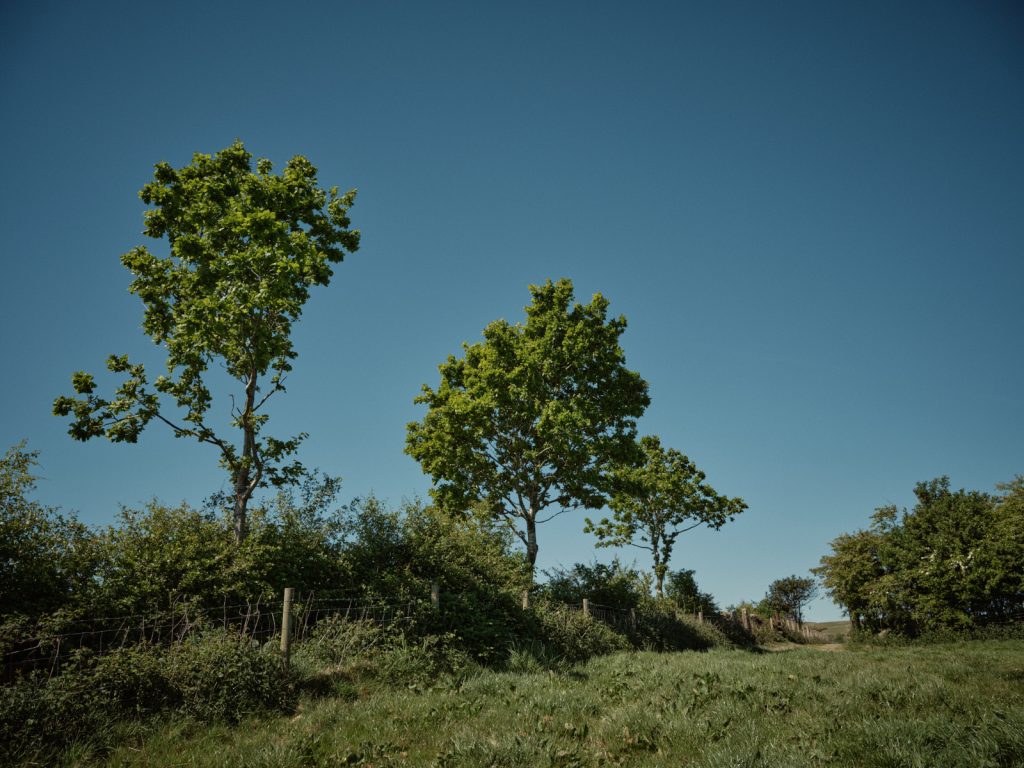
If we’re planting a new boundary or reinstating an old boundary, we will always plant a hedgerow tree every 15-20 m i.e. mountain ash, bird cherries, oak, hornbeam…, willow in wetter areas.
We see the benefit to the fields from the big 6 or 7m wide hedges… people think you’re losing valuable land, but you’re not because you’ve gained for the next 40-50 metres within that field in terms of having a wind break for example, along with all the mycorrhizal activity you get from that hedge. It’s also slowing water down – storing water for longer, which is then releasing back into the field along with nutrients. Planting a hedge down the bottom of a slope means that you’re capturing a lot of nutrients before it’s got a chance to run into a beck and the watercourse as well. We can see from hedges that we’ve planted on the new land that we bought 5-6 years ago how well they’ve done at the bottom compared to the top of the slope, and it’s mainly down to nutrient runoff.
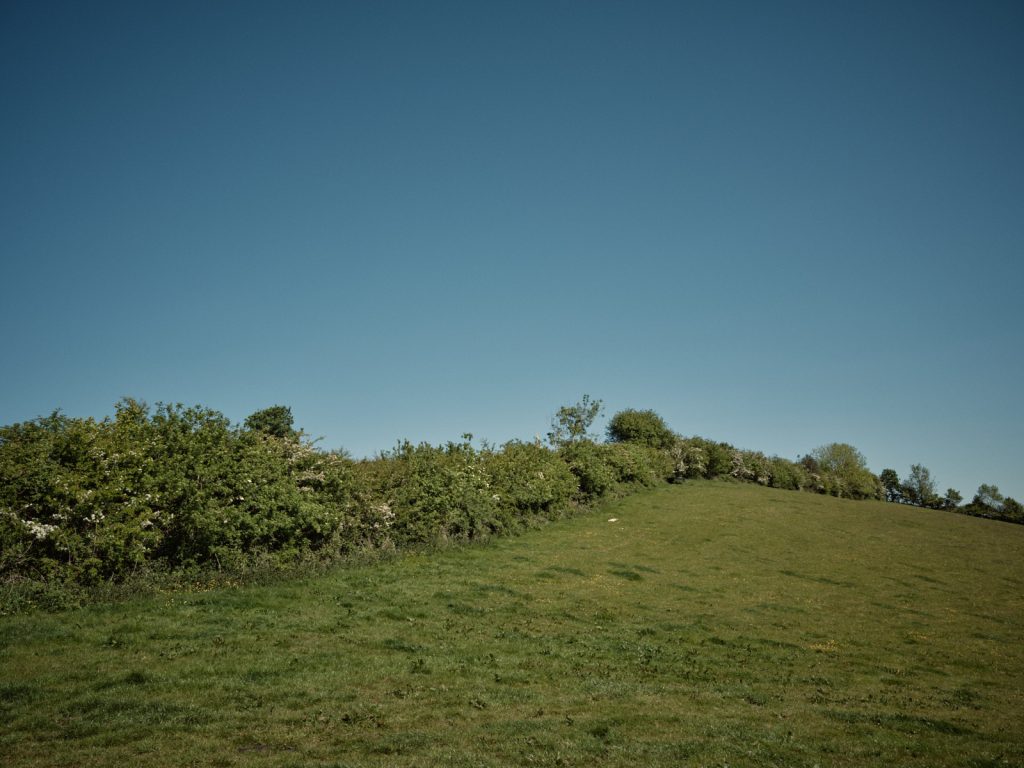
Creating a new hedge
We typically go along with the digger down one side with a fat bucket and tip the soil over and do the same on the other side, so we create a triple layer of topsoil to plant in to, creating drainage down the side of the hedge bank as well. It means we have a deep layer to plant in to and all the organic matter that’s in it then breaks down and creates a really fertile environment for the hedge to establish. We get very good establishment by doing this – 95-98% uptake. It also limits the impact of the existing grasses potentially swamping out the hedge plants we’ve just planted.
The hedgelaying is done in North Lancashire and Westmorland style but we have our own style within that as well.
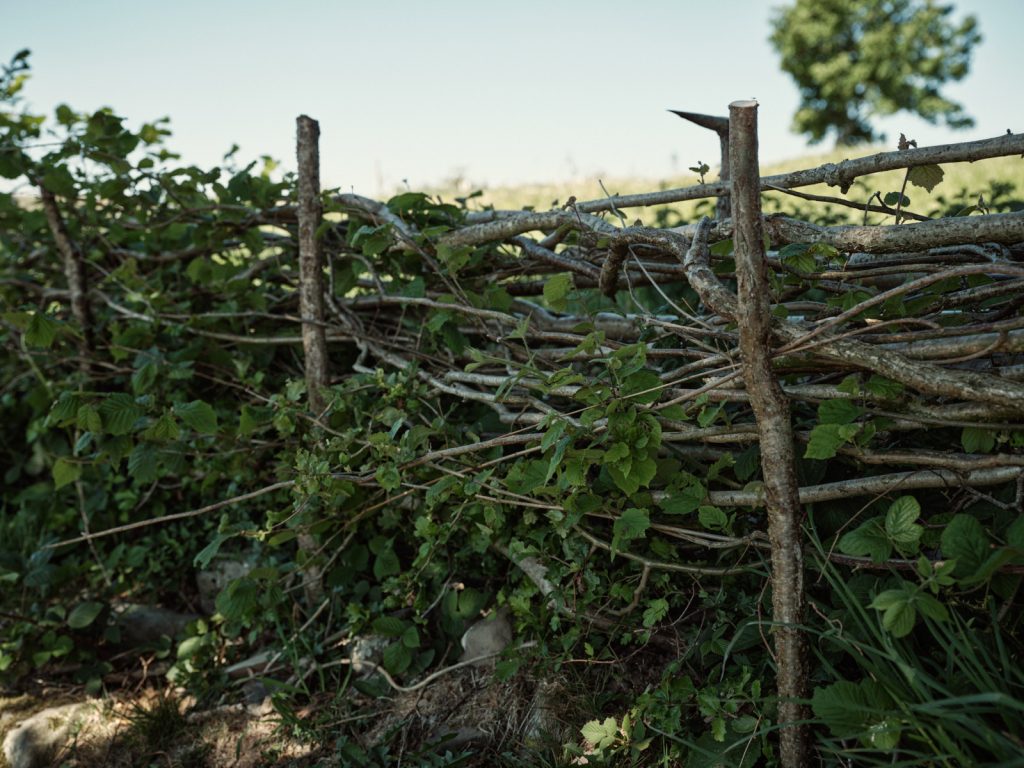
This was put in March 2020 – it didn’t rain for 6 weeks after we’d put it in, and we didn’t water it at all – not watering also creates resilience
Improving ruminant resilience
It’s all about future proofing in terms of climate resilience – getting the cows into those areas with multi species of swards and trees for them to browse from, and the shade and shelter the trees give. Most farmers do some sort of rotational grazing now, but alot of them are on big fields that have been split up often by wire fences- they would really benefit from some sort of tree planting – even if it’s just down the line of access tracks in and out, something to give those cows a chance to browse and provide a bit of shade… Our small fields lend themselves very well to rotational grazing… any trees that we will be putting in will be in-field trees rather than lines of trees.
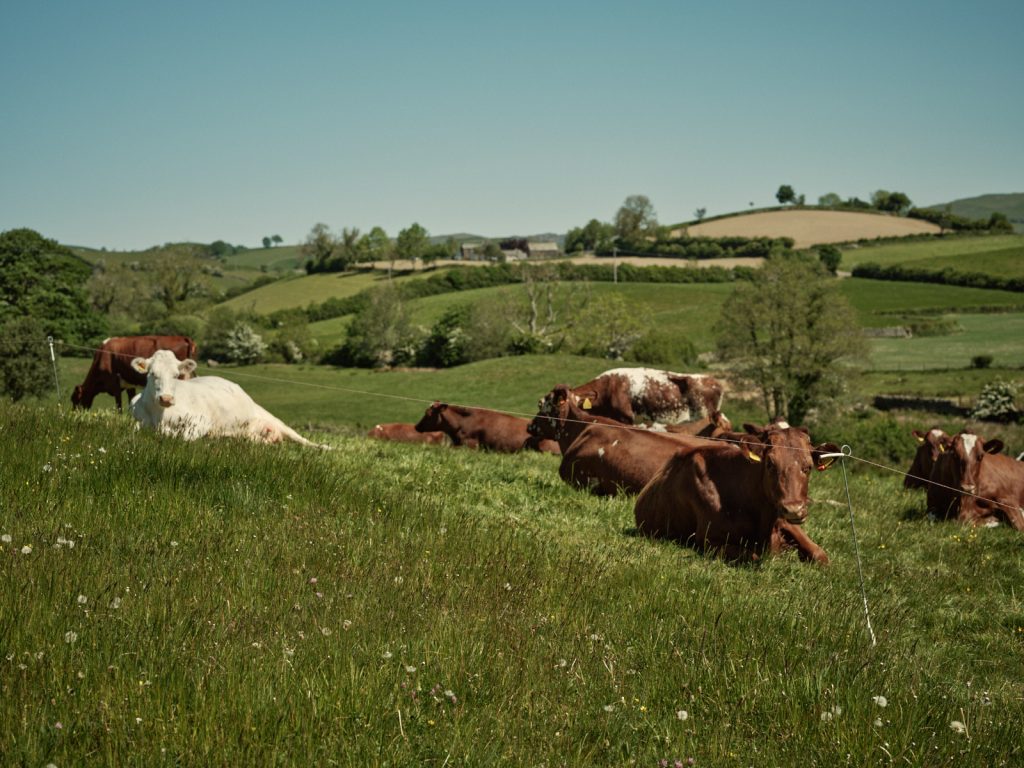
We want to improve our cows all the time but that’s not just in terms of yield, we want to breed cows with good feet and legs that are going to be able to walk down our tracks, cows with a nice big wide chest with plenty of space to fit lots of grass in. They’ve also got to be good converters of fodder (tree fodder, hedge fodder, herbs and everything that’s in the swards…).
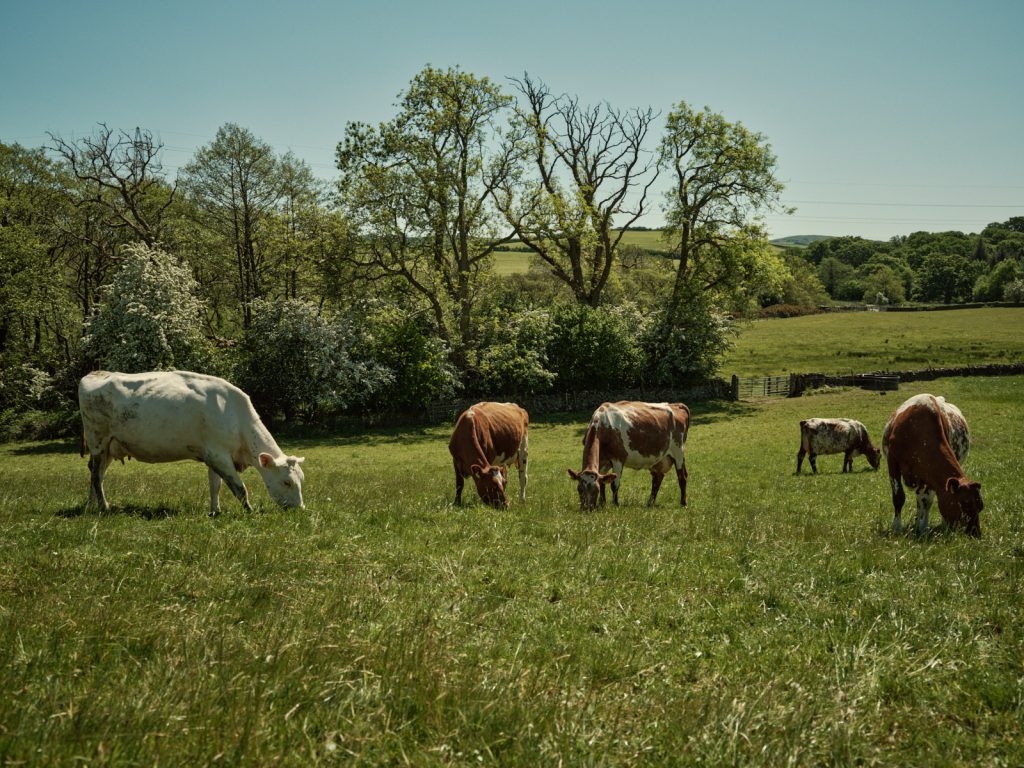
For the health of the animal, I think the best thing you can do with a herd is close it, not so much because of bringing disease into the herd but because the animals that are born here are resilient to all the disease challenges that are on the farm; mastitis for example has very unique bacteria, quite specific to your farm, so if you’ve got animals that are born and brought up on the farm, they’ve already got the resilience in them. Our mastitis rates are very low. Animals know where the trees are that they need to go and browse at a certain time.
Some animals are bred almost for being inside a building and having feed put in front of them, and don’t really know even how to graze grass. Our cows have to! They know how to go out and graze, and that certain hedges will be ready at a certain time, it’s not something we teach them, they just do. The name ‘Strickley’ is very old and means stirc hay – stirc is young cattle of all sexes and ages (not just bullocks). Stirc hay is fodder for the young stock (tree fodder) – so the name is quite apt.
Improving soil structure and water flow
Our farm is probably more resilient than some because of how we’ve managed it over the last 20 years. We’ve introduced herbal lays into quite a lot of the farm because of their deeper and more diverse root structures. 30 years ago, we did away with plants like cocksfoot and timothy in the leys because they were then seen as being second division grasses – it was thought that we should be using modern ryegrasses… But once we became organic, we realised that things still grow without fertiliser but you need something else to get them to grow! So we made sure we had clovers across the whole farm – they’re great for N fixing and pollination, deeper rooting than rye grasses, and higher protein as well for the cows.
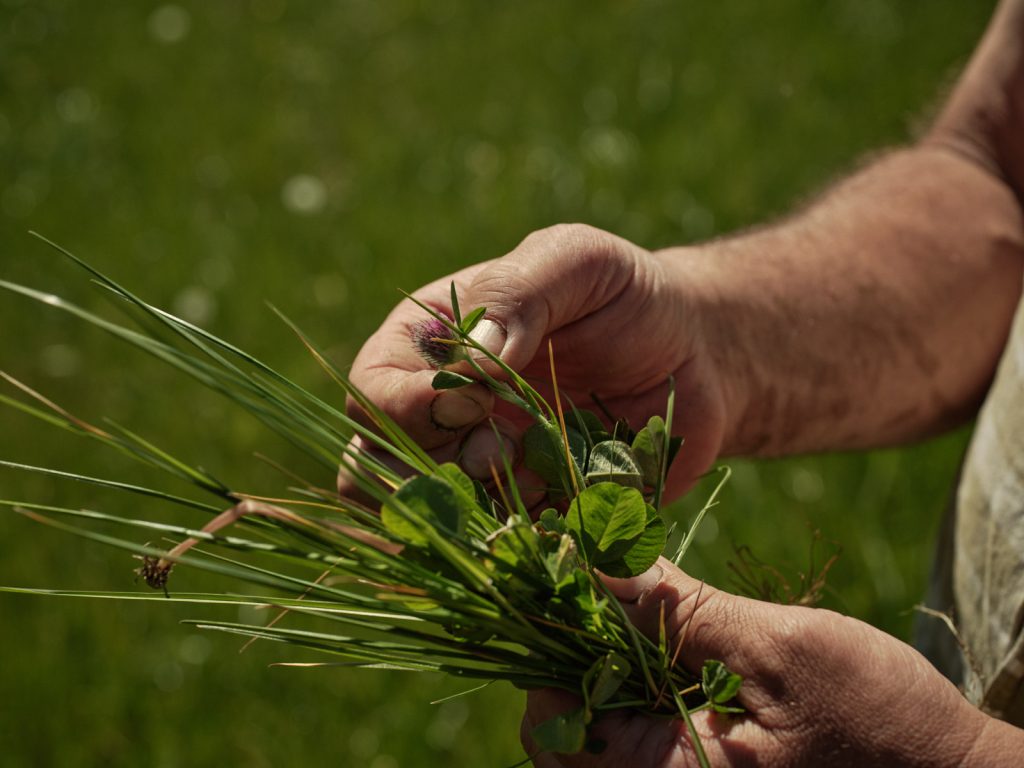
We’ve now started putting timothy and cocksfoot back into the swards, they’re deeper rooting, and cocksfoot is a really drought tolerant plant. The modern varieties are far more palatable and better for energy than they were 30 years ago, so definitely not a second division grass now! We get other benefits as well from other species i.e. chicory and plantain… they are great for animal gut health and deep rooting… then with plants such as fescues, they give real good ground cover lower down so are far better for helping regulate the soil temperature… We’ve just reseeded 8 hectares with herbal leys. For the last 4 or 5 years now we’ve overseeded quite a lot with these diverse seed mixes, but being organic, we do sometimes struggle to get a really good establishment because aggressive or vigorous species can tend to take over… I’m making a list of bird species and have recorded 94 so far throughout the year (winter and summer, so nesting and visitors), and we’ve done plant surveys – recording over 200 species of vascular plants. The hay meadows have got about 100 species in them….
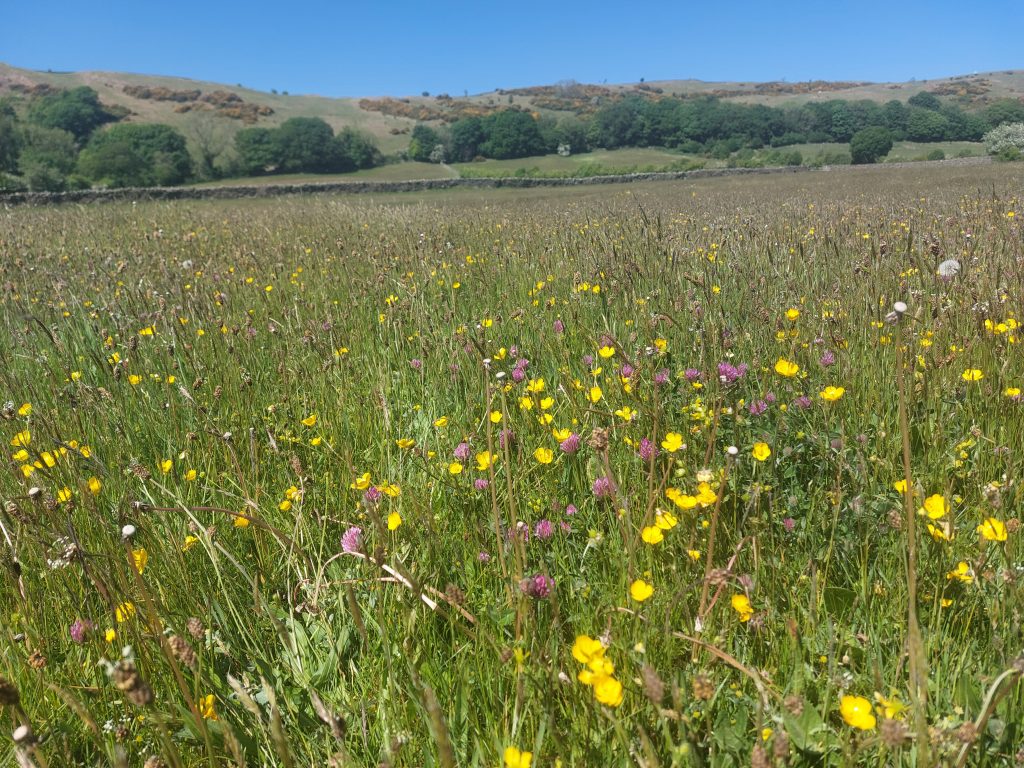
We are fencing off the beck sides quite a lot to keep the stock out and have put in a solar powered water pump system. Our cows are not solely reliant on water troughs though, they still have access to pasture areas and are able to go down a track or into a beck if they have to. Cows can drink a lot of water so they need access to different forms. Everyone is struggling for water at the moment, we’ve tried to prevent that as much as we can, keeping the beck as clear as possible from contamination cows can bring in, but also recognising the benefits that come from having vegetative strips on the side of the beck. They don’t have to be particularly wide, just enough to allow a bit of scrub to grow up, which then creates some shade and temperature control in the water as well. If the cows aren’t going into the beck, it means they’re not disturbing all the life that wants to grow in it i.e. water-crowfoot, which has quite a delicate root. We have some very dense beds of it in the beck.
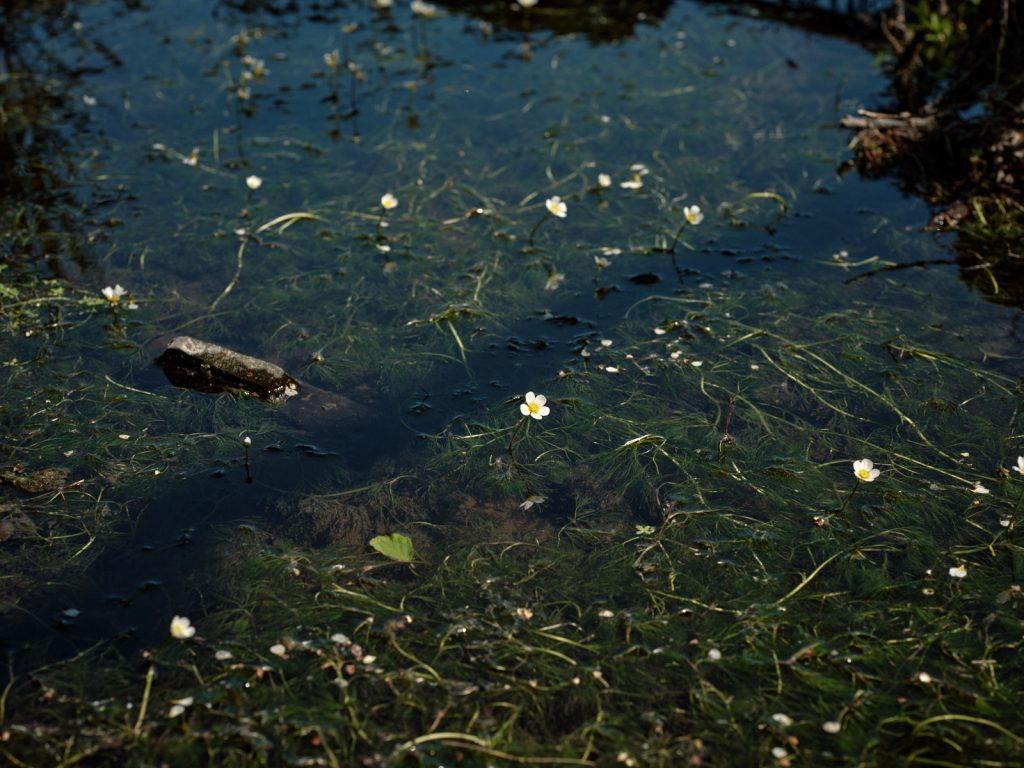
We’re trying to create different areas and habitats using water. We’ve done some renaturalisation and re-wriggling of the beck. We have a 2-ha area which has a gutter down the side of it, we’ve dug it through and created ponds and scrapes. There are 3 different spots where we’ve done similar and created a couple of ponds, plus another bit further down with wet woodland. Having standing water on the farm is very important, you can see how much life there can be just through looking at the water trough. The trees help with holding the water as well as releasing it, and up by the side of streams, getting a bit of shade in there to keep the temperature down is important because it changes a lot between shady and open bits. If you need to fence a beck off, stick a few trees in as well…
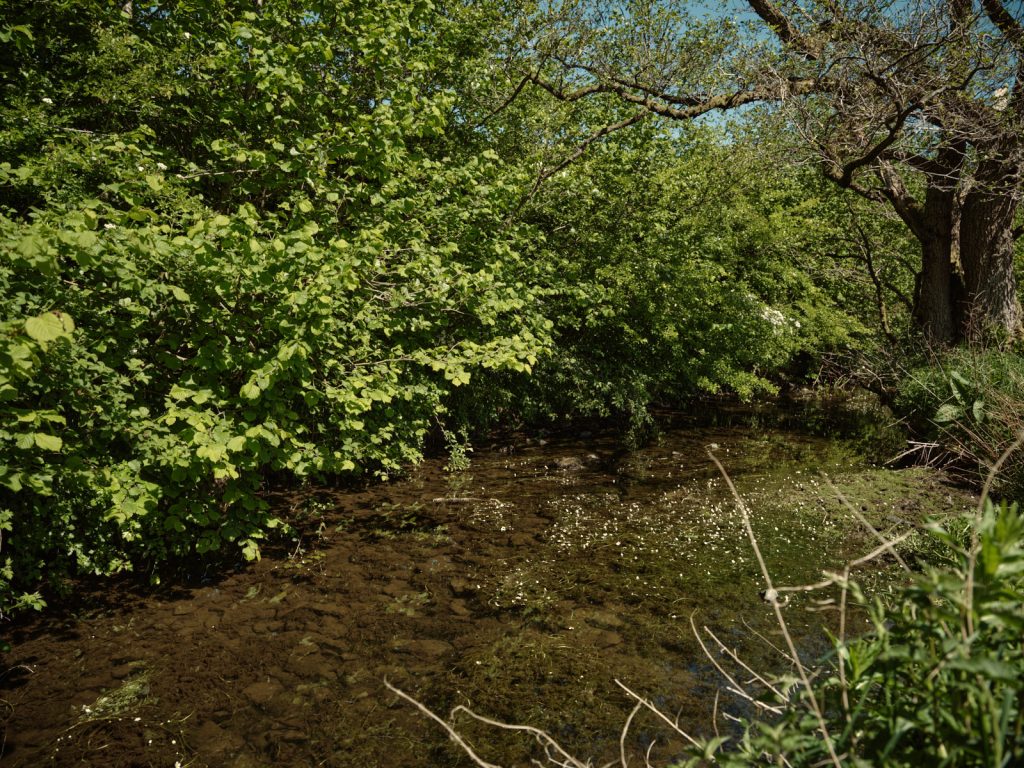
The local river trust carries out fish counts of the beck (mainly trout) and Michelle and I have done river fly surveys, learning about the microscopics we can barely see… poor counts of those, and you know that something’s wrong with the water quality.

4 years ago, the area pictured above was fenced off. Before then, the stock used to go into the beck for water. We do the fish counts in this kind of area. We dug a little back channel up (see below) which provides a refuge for when its flooded. Danny Teasdale from Ullswater CIC came over and advised us. We have now created a wet woodland and have fish in the wood! We bring school visits here – they do a bit of beck dipping.
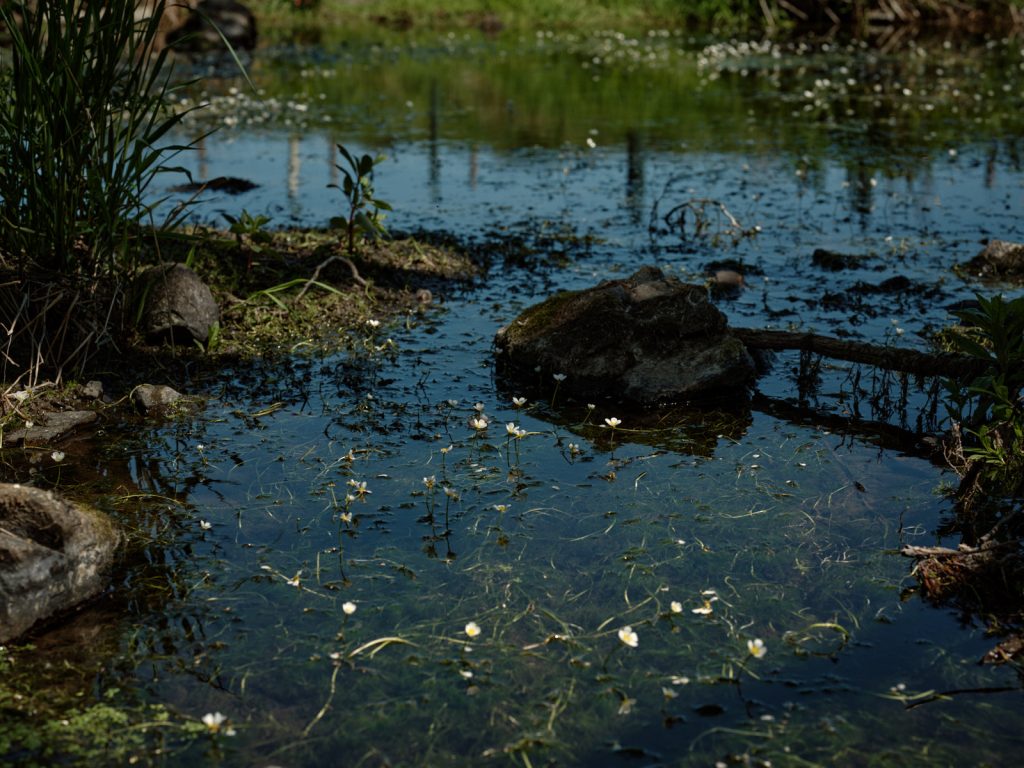
When the tree below came over after some heavy flooding (25 / 30 years ago), we wanted to take it out but ended up leaving it and it is now supporting a huge habitat and has helped create a deep pool and a couple of gravel beds which are great for fish habitats…
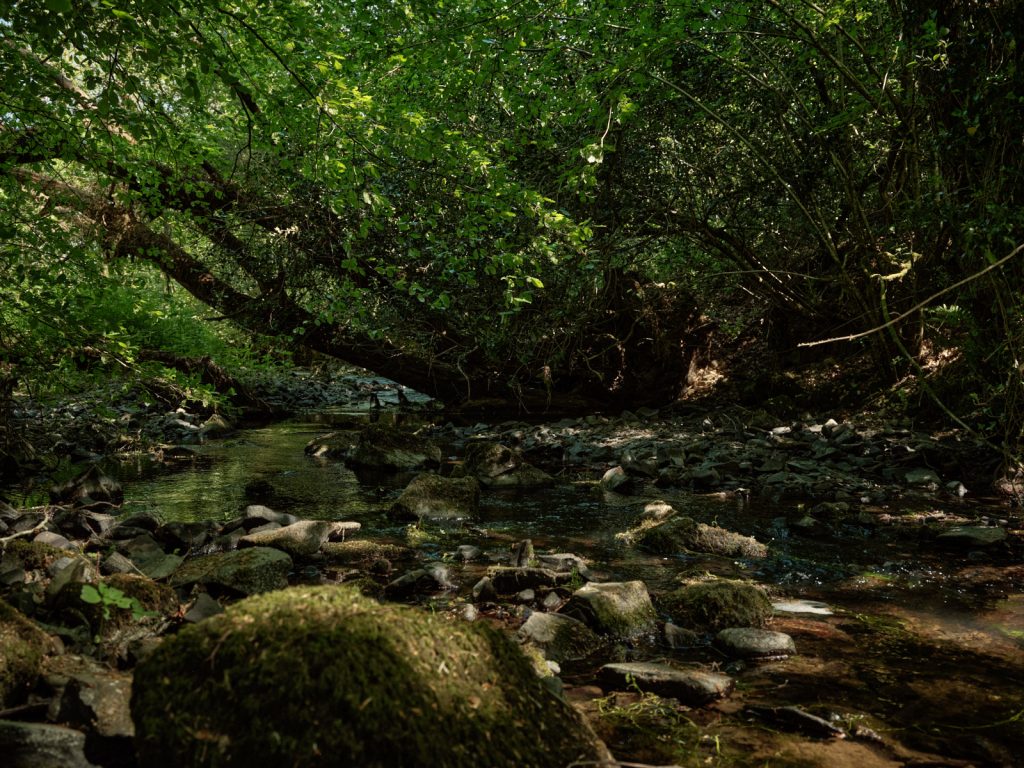
Trees that have been allowed to stay where they have fallen support lots of life – invertebrates, spiders, mosses, lichens, ferns… Give nature time sometimes and see what happens…
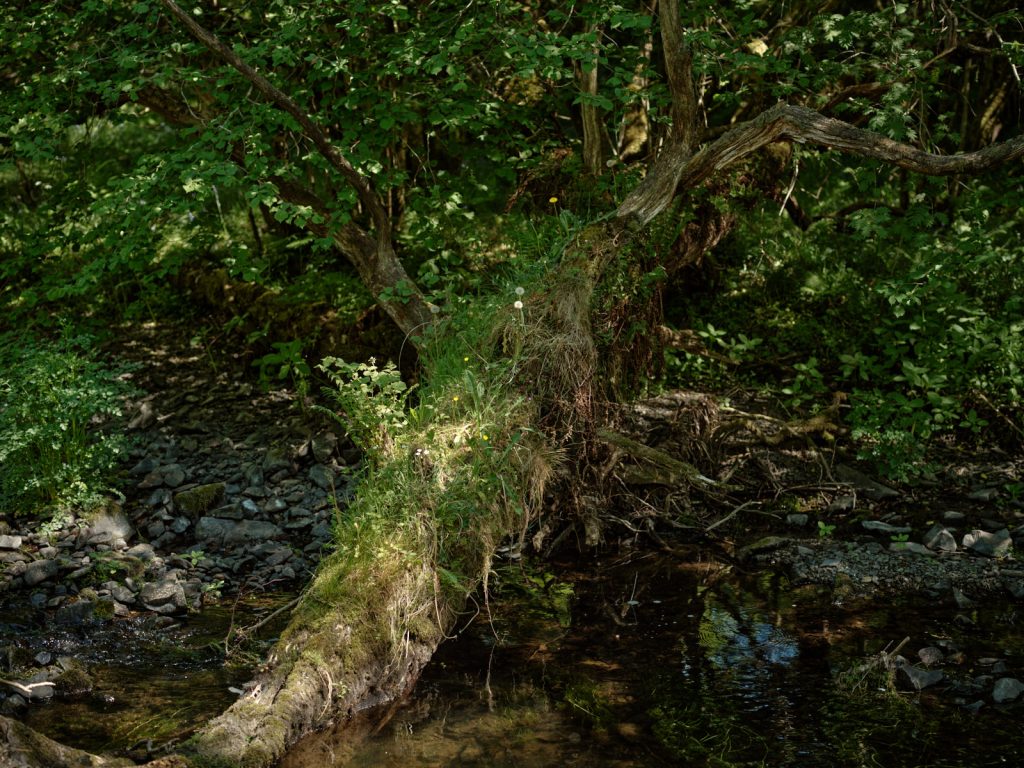
Future vision – Land App case study
Whinny Lot field is currently under a stewardship scheme, so we can’t do anything with it at the moment. I still have a vision to plant trees in it and still will. It’s not a field that we’re ever going to plant crops on or plough, as a lot of it is quite close to the rock. It has got quite a nice diverse sward in it anyway, but there’s very little shade and shelter within the field and when the wind comes across from the southern end, it goes straight across… There’s a wall across one side but it creates a very hard line and tends to create a lot of humidity, so we have softened that edge a bit – because we can’t plant in the field at the moment, we’ve planted the other side of the wall up with some trees and scrubby species as well. Some of the trees were donated from the Woodland Trust who gave us 15 oaks for the Strickley 150th anniversary, and we have also planted scrub such as hazel and thorn that will then break the wind up a bit as it comes across.
The existing trees are getting nice and big but we still very much want it to be a wood pasture rather than a woodland… we’ll see the benefits to the cows when they’re grazing as well. Our plan is to create some wood pasture hopefully in 18 months’ time. This will partly depend on what stewardship schemes are available. Will the capital work that needs doing be paid for? To guard all the trees, we’ll have to use cactus guards. Will there be some sort of scheme that’s going to be able to pay for 10 years for establishment and management as well? It will have a big effect on what we do.
Motivations and future goals
If we see something new to the farm that has come here because of the way that we farm, whether that’s a butterfly, bird or flower, I get quite excited about it, especially if it’s on a piece of habitat that we have created or changed the management of… Alot of things are almost unexpected, we don’t design something specifically for one thing, we just try and improve the habitat, which hopefully will encourage other things to come in. Every time I see something new or something that’s going well, it backs up what we’re doing. Seeing the results of what we’re already doing is enough for me to keep doing what is right.
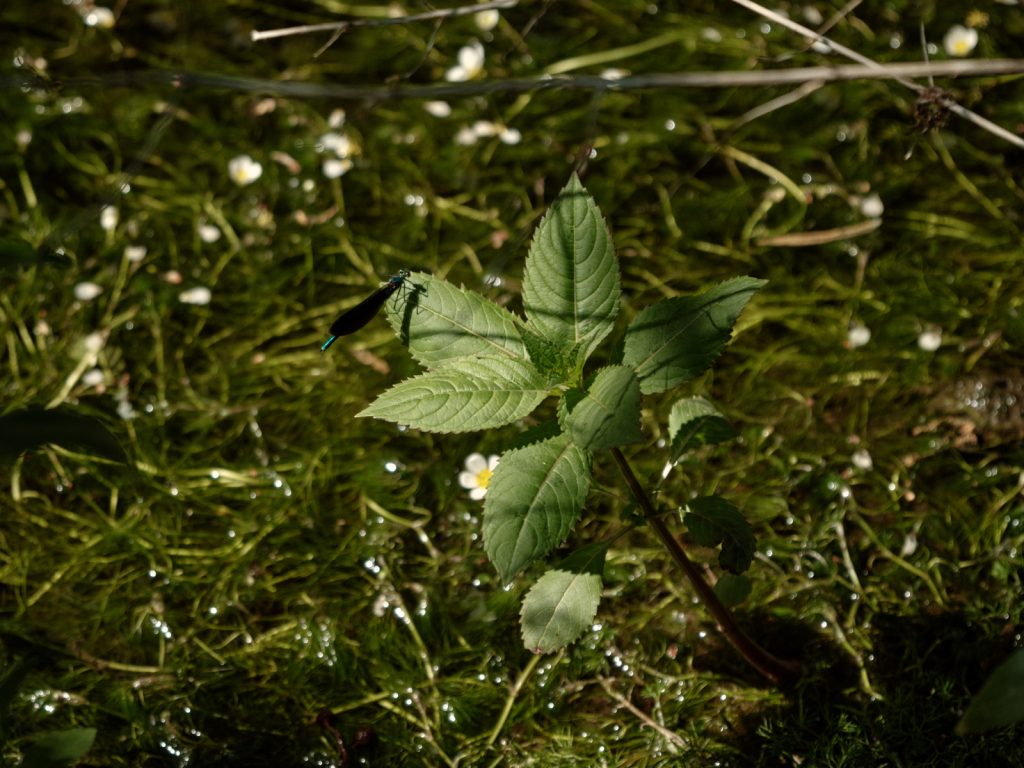
I’ve always loved nature – most of my summer holidays were spent messing about by the beck, and then in wintertime, hedging with the family… It wasn’t something odd or different, it was very much just part of what we did. The things that we do for habitats and nature, whether that’s planting a tree, managing a hay meadow or laying a hedge, aren’t any different from getting the cows in for milking or clipping a sheep. It’s all just part of the day-to-day running of the farm, and it’s always been that way. I think that’s kind of why we still do what we do, along with very much seeing the benefits to the farm, to nature and to us… it makes it a far better place in which to work and spend the day. They’re long days, we might as well have something nice to look at or listen to!
Farming is a long-term game, so we continue to improve on breeding the right type of cow – it can take many years, no one’s ever bred the perfect cow! You’ve always got to try and improve on it, and that isn’t just in relation to yields, it’s the cow’s ability to convert the grass and live in the environment of this farm. In terms of the number of animals in the herd, I think we’re about right for the farm, increasing it would mean we’d have to buy more feed in… Trees are very much a long-term thing as well. We need to get trees and hedges in today to see the benefits. A hedge can quickly become wind break within a few years, and a tree can quickly provide a bit of shade. There’s some that we put in 18 months ago, and the trees are already 2-3m tall, providing some shade, and breaking the wind up…
Having that resilience right across the farm; be it areas where the cows can go for shade and shelter, water going out to fields, big hedges, or the right type of species in the sward the cows eat… They are our future goals – to just try and improve on that all the time.
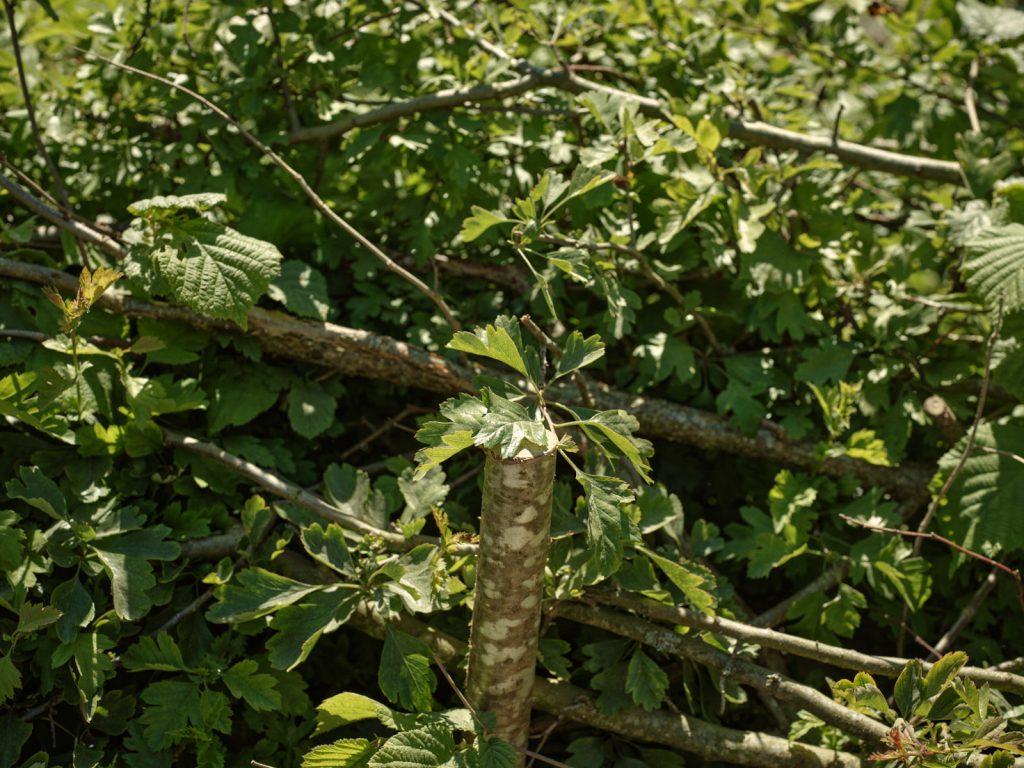
Farmer tips
- Improve the management of your hedges! Everyone can manage hedges better. If you only have a single species such as hawthorn in a gappy hedge, don’t plant hawthorn back in, get some hazel, bird cherry or crab apple in there as well.
- If you don’t want to plant any in-field trees, remember you can incorporate trees into your hedges… rather than seeing it as a hindrance to the way you’re managing that hedge, see it as a benefit for everything that the trees will bring.
- Look and see how your cows interact with trees (particularly browsing), you’ll see the benefits of that and come to know how better to manage their movements.
- If you want to improve something, take a fence down or put a fence up. It’s generally just as simple as that. It doesn’t have to be complicated either in terms of improving habitats… just graze your livestock slightly differently.
- There are some good innovations at the moment for tree establishment that allow us to still farm productively. It’s important not to see it as giving land over to woodland, it’s an integral part of the farm.
This profile was created by Janie Caldbeck on behalf of the Woodland Trust
With very many thanks to James Robinson, and Duncan Elliott for the photography and drone footage
Photo credits: All those not stated are taken by Duncan Elliott. Copyright for all photos: All Rights Reserved
You may also be interested to explore the following:
https://agricology.co.uk/resource/future-proofing-dairy-farms-through-landscape-design/
https://www.youtube.com/watch?v=rsyhi1fqBFI
https://www.nffn.org.uk/farmer-stories/james-robinson
https://www.soilassociation.org/certification/farming/meet-our-licensees/james-robinson-strickley-farm/
https://shows.acast.com/we-can-do-both-pod/episodes/nature-friendly-dairy-farming-with-cumbrias-james-robinson
